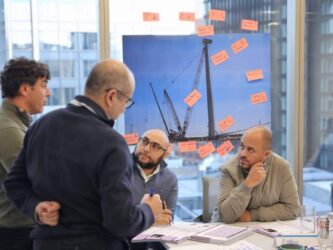All business decisions create risks and opportunities. And the choices made at the contracting stage are no different. But in scoping, planning and delivering wind power projects, many developers fail to factor in how their contracting models affect business and safety risk across the asset lifecycle.
For most developers and asset owners, contracting structures are determined solely by short-term financial and capital investment imperatives. And this is where the problem lies. In attracting and satisfying investors, attention is rarely paid to the effect contracting strategy has on life-cycle risk. But it is this failure that, in the longer term, will only increase risk, reduce performance and add cost.
At ARMSA Academy, we know that health and safety is an emergent property of the decisions a business takes. We also know that it is often the very decisions a business wouldn’t normally associate with health and safety that end up being most critical. At the earliest stage in a project, developers need to take a broader view of the risks inherent in their contracting strategies, looking at the whole wind power project lifecycle, including how to control the build-out, operation and maintenance (O&M) of the asset.
Conflicting objectives?
In a project’s initial phases, when developers are deciding how to bring the key work package providers together (for the turbines, balance of plant, and civil works), they are focusing on cost optimisation. The primary goal is to produce an attractive investment memorandum – a compelling business case for approval and funding. At this stage, contracting strategy is rarely a conscious decision from a project management or control perspective. No one stops to ask: “What is the best way to organise the key players so we can manage a well-controlled construction, installation and commissioning activity?”
When the relationship between a developer and the key work package providers is structured to deliver cost optimisation, it lends itself to a multi-contracting strategy. And it’s that strategy, aimed primarily at satisfying investors, that later determines how the wind power project is controlled when it moves into the construction and installation phases.
This type of contracting strategy, however, is not set up to deal with wider project control, and is poorly aligned with the regulatory system in which the project operates. In Europe, health and safety regulators have long recognised the need for a clear chain of responsibility linking all the parties involved. Key to this chain is the role of a centralised single central contractor (in the UK, a principal contractor or PC).
This regulatory approach is more closely aligned with the EPC (Engineering Procurement and Construction) contracting model, where a developer engages a single contractor responsible for all aspects of engineering, procurement, construction, installation and commissioning, including the coordination of multi-tier contractors on site.’
Aligning strategies
So, how can organisations resolve any potential mismatch between the multi-contract approach, which is most attractive commercially, and a regulatory approach that favours a more EPC style relationship?
There are various options. In theory, the developer could take the PC role, offering a single point of contact and coordinating the three main work package contractors. But this assumes the developer has engineering, procurement, construction and project management competence within its team. Where the developer is a renewables investment platform or new market entrant, for example, without a strong project management or construction background, the situation is more complicated. In this case, the organisation might persuade one of its main work package contractors (often civil works) to take the role. However, this contractor may know little about the other packages and may not be competent to oversee the entire work.
Another option is to bring in a third party project manager. The problem here, however, is that this risks de-linking the financial control implicit in the contractual relationship between the developer and work package providers from project control. And when you separate financial control from construction control, the project manager ultimately lacks any financial leverage over the contractors it is supposed to be managing.
How agile are you?
How can developers factor in risk at the earliest stage? The starting point is to acknowledge the challenges. When you understand the effect your contracting strategy can have over the project lifecycle, you can build-in these issues and, either alter your strategy, or implement robust safeguards.
When developing a project, try not to approach it from a narrow financial standpoint. Be realistic in terms of the build-out and O&M phases – and ask what the role of the developer and asset owner should be in those phases.
Related to this, make sure you understand the legal requirements governing construction and O&M. Talk to colleagues who work in these areas so you understand the constraints and challenges they face. Then ensure the investment memorandum is as close to reality as possible, and doesn’t inadvertently prioritise investor attraction over the effective safe and healthy delivery of the project on time and on budget.
Where you have to adopt a particular contract strategy to minimise the cost base, consider how the project will be controlled during construction, and develop a plan for ensuring the organisation acting as PC has maximum leverage over those delivering the project.
If all this means building a supporting risk register alongside the investment memorandum, then do that. It will mean the contractors who take over the project in the construction and O&M phase understand the risks and can mitigate them.
Finally, incorporate the cost of those mitigations into your overall levelised cost of energy (LCOE) model. This will mean everyone understands the financial impacts of the choices made in the development stages on the return of the wind power project across its lifecycle. In this way, the financial modelling will no longer be just CapEx (capital expenditure) oriented, but CapEx plus OpEx (operational expenditure) for each of the years you intend to operate the asset.
Successful organisations recognise they need to look for risks and opportunities at each decision step. But too many still overlook the impact the early financial decisions that dictate their contracting strategies have on the risk and safety profile of a project.
Developers need to think more broadly and creatively about the factors that influence their choices in procuring and managing contractual relationships across their wind power project portfolios. As the industry expands, organisations that can take a more flexible, agile and risk-based approach to their contracting strategies will see the greatest returns in terms of reduced costs, and improved business and safety performance.
Resources:
- Read more about how the shifting relationships that typify a joint venture’s contracting structure may conflict with safety requirements here.
- Listen to further analysis of how contracting strategies influence risk here.
- Enjoyed this thinking post? Check out our performance support sprint demos here.
Risk-based contracting: how agile are you? © 2021 by Khalida Suleymanova – ARMSA is licensed under CC BY-NC-ND 4.0






